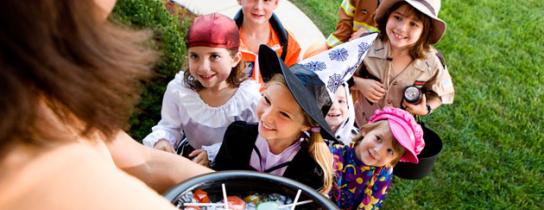
How to Have a Safe and Healthy Halloween by Crystal Run Healthcare Pediatrician, Aimée Kahn, MD
Expert tips to stay safe while trick-or-treating
It is finally fall! The time of year when parents can get their fill of pumpkin spice lattes, or pumpkin anything for that matter, and children get the opportunity to dress up for Halloween—has your child decided on a costume yet? An action hero, prince or princess, their favorite animal or athlete, or object (I’ve seen kids dressed at hotdogs!). You could even go with a family theme and get everyone in on it. No matter what you choose, it is bound to be a fun time, as long as you celebrate safely.
There are a few things to keep in mind during this festive and exciting time of the year to create a fun and safe environment.
Plan your trick-or-treat route.
Walking around your neighborhood and nearby neighborhoods is a fun way to not only help children collect candy; it's also a great way to get in some exercise before indulging in all those goodies! You can even prepare before Halloween and start going for walks to determine what the best route is for the big night. There are always ways to squeeze in exercise with kids, especially if you make it fun.
Set guidelines with your children.
Children ages 12 and younger should trick-or-treat with an adult and be supervised at all times. Older children should be counseled to stay in well-known areas with a route that is determined beforehand. They should avoid homes without a light on and refuse to enter anyone’s home. Stay in a group with friends who also know the prearranged route. Be sure to cross at the street corners, looking both ways before crossing, and put down electronics and cellphones while doing so. When visiting house-to-house, be sure to use sidewalks and bring flashlights or glow sticks to help lighten the path. If the child has a cellphone, there are a number of apps available to track where they are. It is also a good idea to discuss who to call and where to go if any emergency occurs, or if the child has any concerns.
Ensure costumes are safe.
Making costumes colorful and bright helps to identify children when it is dark out, and you can add some reflective tape to costumes and trick-or-treating bags. Additionally, parents should ensure that their child’s costume is a good fit, which will help to prevent trips and falls from oversized outfits. Costume accessories should be safe—not too sharp, too heavy, or dangerous.
Sort candy first, eat later.
Regarding candy, it’s best to hold off eating any treats until the children have arrived back home and parents can go through their candy bags to ensure which candy is acceptable—this includes avoiding unopened candy, as well as hard and sucker candies for younger children. And, of course, if your child has any allergies, be sure to read all the labels. Waking up with a bellyache Nov. 1 is never fun, so it is best to have children choose a few (one-three) of their favorite treats to enjoy Halloween night and then slowly give the rest out over the next few days to weeks.
Above all, remember to have fun!

 Optum Radiology at Crystal Run Healthcare
Optum Radiology at Crystal Run Healthcare Request medical records online
Request medical records online